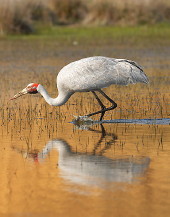- «Home
- «Research |
- Brolga Thesis, K King
Brolgas in SW Victoria: K King 2008
Brolgas are threatened (‘Vulnerable’) in southern Australia. For eight months of the year, Brolgas form non-breeding flocks to roost and seek food in wetlands and agricultural sites. For her Bachelor of Environmental Science (Honours) at Deakin University in 2008, Kristie King studied Brolgas in SW Victoria during the ‘flocking’ season. With help from landowners in the Penshurst and Willaura districts she followed Brolgas as they flew between roost and feeding sites, and studied their preferred habitats, feeding behaviour and movement patterns. Kristie's work provides a basis for land managers and others to reduce threats and improve habitats for Brolgas in Victoria's southwest, and for further research.
Location: Hamilton is 290 km west of Melbourne, capital city of the state of Victoria in SE Australia. From Hamilton by road, Penshurst (37.966o S, 142.25o E) is about 30km to the SE and Willaura (37.532o S, 142.71o E) is about 70km to the NE (see sidebar maps).
Kristie can be contacted by Email.

Kristie Anne King: Deakin University, Victoria, Australia
Title
Behaviour patterns and habitat use of the Brolga Grus rubicundus at two flocking sites in south-west Victoria
Abstract
The Brolga Grus rubicundus is Australia's only endemic crane species. Brolga numbers in southern Australia have declined significantly over the last century due to widespread loss of wetland habitats for agriculture. Flocking sites support Brolgas for up to eight months of the year and are therefore an important component of Brolga ecology and conservation. This study sought to obtain baseline information on the spatial requirements of Brolgas at the intra- and inter-site scales. Behavioural and patch use observations were used to assess time budgets, activity patterns, foraging behaviour and foraging ranges of Brolgas at two sites in south-west Victoria.
Habitat use and flocking site selection in Brolgas were found to be dynamic both spatially and temporally. Furthermore, it was found that flocking Brolgas require access to a complex of habitat features distributed in such a way as to minimise energetic travel costs. Important habitat features at flocking sites were determined to include: permanent, protected wetlands for roosting (nocturnally and diurnally); fresh drinking water; crop lands and/or intact waterplant assemblages; and animal food items which provide essential protein and calcium.
Management of Brolga flocking habitat in south-west Victoria should focus on improving the availability and quality of essential habitat features, particularly wetland roosting, drinking, foraging and loafing sites which seem to be limited in availability. As Brolgas appear to be exhibiting preferential flocking site selection, potential risks associated with between-site migrations should be determined and addressed. Future research should focus on detailing the role of temporal and spatial heterogeneity in Brolga habitat use via comprehensive habitat sampling and the application of genetic and stable isotope analysis and telemetry techniques.
Read Kristie's whole thesis » (76 pages, pdf 1.07MB). Acknowledgements for support and assistance are on page ii.
..more on Ozcranes
- Thesis Abstract: Flocking habitat Rebecca A Sheldon, 2004»
- Study: Breeding habitat Claire Harding, 2001»
- Study: Breeding ecology and conservation Matthew Herring & others, 2001»
- Matt Herring writes about his project: ‘Dancing Brolgas’»
- Inka Veltheim PhD Study, Brolga population SW Victoria»



